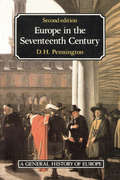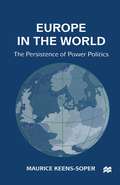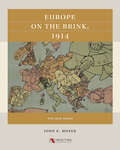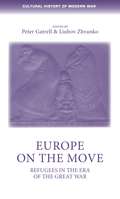- Table View
- List View
Europe in the Contemporary World: A Narrative History with Documents
by Bonnie G. SmithThis newly updated and improved edition of Bonnie G. Smith's classic textbook provides the most authoritative history available of Europe in a global context during the 20th and 21st centuries. It cleverly incorporates elements of political, social, cultural, economic and intellectual history and presents an integrated history with detailed coverage right across the continent.Including 131 images and 23 maps, Europe in the Contemporary World: 1900 to the Present is organized around key themes within a chronological chapter structure that is easy to follow. Smith's balanced treatment of the subject allows for a comprehensive assessment of the positive and negative developments in European history over the period, as well as the wider impact of this in the world at large. The book also includes picture essays and document sections, which provide variety and foreground the importance of primary sources, and useful end-of-chapter further readings for students who wish to investigate specific topics in greater depth.The enhanced 2nd edition contains:* A new chapter on the 21st-century issues that have challenged and continue to challenge Europe* More material on globalization, the end of the Cold War, European countercultures and various other topics* Historiographic updates throughoutEurope in the Contemporary World: 1900 to the Present is the definitive guide to Europe and its place in the world since 1900 for students and scholars alike.
Europe in the Contemporary World: A Narrative History with Documents
by Bonnie G. SmithThis newly updated and improved edition of Bonnie G. Smith's classic textbook provides the most authoritative history available of Europe in a global context during the 20th and 21st centuries. It cleverly incorporates elements of political, social, cultural, economic and intellectual history and presents an integrated history with detailed coverage right across the continent.Including 131 images and 23 maps, Europe in the Contemporary World: 1900 to the Present is organized around key themes within a chronological chapter structure that is easy to follow. Smith's balanced treatment of the subject allows for a comprehensive assessment of the positive and negative developments in European history over the period, as well as the wider impact of this in the world at large. The book also includes picture essays and document sections, which provide variety and foreground the importance of primary sources, and useful end-of-chapter further readings for students who wish to investigate specific topics in greater depth.The enhanced 2nd edition contains:* A new chapter on the 21st-century issues that have challenged and continue to challenge Europe* More material on globalization, the end of the Cold War, European countercultures and various other topics* Historiographic updates throughoutEurope in the Contemporary World: 1900 to the Present is the definitive guide to Europe and its place in the world since 1900 for students and scholars alike.
Europe in the Eighteenth Century 1713-1789 (General History of Europe)
by M. S. AndersonFor 1st and 2nd year undergraduate courses in Modern European History in departments of history. Also, higher level courses on enlightenment.This book provides a wide-ranging account and discussion of the history of Europe from 1713-1789. As well as political events, problems and institutions, it looks at the economic life of the continent, social structures and problems and intellectual and religious life. It also covers all aspects of Europe's relations with the rest of the world during a key period in European history.
Europe in the Eighteenth Century 1713-1789 (General History of Europe)
by M. S. AndersonFor 1st and 2nd year undergraduate courses in Modern European History in departments of history. Also, higher level courses on enlightenment.This book provides a wide-ranging account and discussion of the history of Europe from 1713-1789. As well as political events, problems and institutions, it looks at the economic life of the continent, social structures and problems and intellectual and religious life. It also covers all aspects of Europe's relations with the rest of the world during a key period in European history.
Europe in the Era of Two World Wars: From Militarism and Genocide to Civil Society, 1900-1950
by Volker R. BerghahnHow and why did Europe spawn dictatorships and violence in the first half of the twentieth century, and then, after 1945 in the west and after 1989 in the east, create successful civilian societies? In this book, Volker Berghahn explains the rise and fall of the men of violence whose wars and civil wars twice devastated large areas of the European continent and Russia--until, after World War II, Europe adopted a liberal capitalist model of society that had first emerged in the United States, and the beginnings of which the Europeans had experienced in the mid-1920s. Berghahn begins by looking at how the violence perpetrated in Europe's colonial empires boomeranged into Europe, contributing to the millions of casualties on the battlefields of World War I. Next he considers the civil wars of the 1920s and the renewed rise of militarism and violence in the wake of the Great Crash of 1929. The second wave of even more massive violence crested in total war from 1939 to 1945 that killed more civilians than soldiers, and this time included the industrialized murder of millions of innocent men, women, and children in the Holocaust. However, as Berghahn concludes, the alternative vision of organizing a modern industrial society on a civilian basis--in which people peacefully consume mass-produced goods rather than being 'consumed' by mass-produced weapons--had never disappeared. With the United States emerging as the hegemonic power of the West, it was this model that finally prevailed in Western Europe after 1945 and after the end of the Cold War in Eastern Europe as well.
Europe in the Era of Two World Wars: From Militarism and Genocide to Civil Society, 1900-1950
by Volker R. BerghahnHow and why did Europe spawn dictatorships and violence in the first half of the twentieth century, and then, after 1945 in the west and after 1989 in the east, create successful civilian societies? In this book, Volker Berghahn explains the rise and fall of the men of violence whose wars and civil wars twice devastated large areas of the European continent and Russia--until, after World War II, Europe adopted a liberal capitalist model of society that had first emerged in the United States, and the beginnings of which the Europeans had experienced in the mid-1920s. Berghahn begins by looking at how the violence perpetrated in Europe's colonial empires boomeranged into Europe, contributing to the millions of casualties on the battlefields of World War I. Next he considers the civil wars of the 1920s and the renewed rise of militarism and violence in the wake of the Great Crash of 1929. The second wave of even more massive violence crested in total war from 1939 to 1945 that killed more civilians than soldiers, and this time included the industrialized murder of millions of innocent men, women, and children in the Holocaust. However, as Berghahn concludes, the alternative vision of organizing a modern industrial society on a civilian basis--in which people peacefully consume mass-produced goods rather than being 'consumed' by mass-produced weapons--had never disappeared. With the United States emerging as the hegemonic power of the West, it was this model that finally prevailed in Western Europe after 1945 and after the end of the Cold War in Eastern Europe as well.
Europe in the Fourteenth and Fifteenth Centuries (General History of Europe)
by Denys HayThe second edition of this highly successful textbook analyses the structure of later medieval society in Europe, identifies its main groups and their political programmes, and examines their impact on the political, economic and social history of the major European states. There are many additions and expansions in this new edition, and the important chapter on the Central Monarchies (of Poland, Hungary, Bohemia, Rumania and Lithuania) has been newly contributed by Professor J M Bak of the University of British Columbia.
Europe in the Fourteenth and Fifteenth Centuries (General History of Europe)
by Denys HayThe second edition of this highly successful textbook analyses the structure of later medieval society in Europe, identifies its main groups and their political programmes, and examines their impact on the political, economic and social history of the major European states. There are many additions and expansions in this new edition, and the important chapter on the Central Monarchies (of Poland, Hungary, Bohemia, Rumania and Lithuania) has been newly contributed by Professor J M Bak of the University of British Columbia.
Europe in the High Middle Ages: The Penguin History of Europe (The\penguin History Of Europe Ser.)
by William Chester JordanWith a lucid and clear narrative style William Chester Jordan has turned his considerable talents to composing a standard textbook of the opening centuries of the second millennium in Europe. He brings this period of dramatic social, political, economic, cultural, religious and military change, alive to the general reader. Jordan presents the early Medieval period as a lost world, far removed from our current age, which had risen from the smoking rubble of the Roman Empire, but from which we are cut off by the great plagues and famines that ended it. Broad in scope, punctuated with impressive detail, and highly accessible, Jordan's book is set to occupy a central place in university courses of the medieval period.
Europe in the High Middle Ages: 1150-1300 (General History of Europe)
by John H. MundyA revised and updated new edition of Professor Mundy's lively introduction to Europe 1150-1300. It provides a portrait of the social, economic, political and intellectual life of Latin Christendom in the period. Wherever possible the men and women of the high middle ages are allowed to speak for themselves as Professor Mundy makes wide use of contemporary sources xxx; bringing alive the complexities and concerns of people living in medieval times. Another strength of the book is the attention devoted to groups often marginalised in other histories; looking at the experience of women, for instance, and that of the Jews in a predominantly Christian society.
Europe in the High Middle Ages: 1150-1300 (General History of Europe)
by John H. MundyA revised and updated new edition of Professor Mundy's lively introduction to Europe 1150-1300. It provides a portrait of the social, economic, political and intellectual life of Latin Christendom in the period. Wherever possible the men and women of the high middle ages are allowed to speak for themselves as Professor Mundy makes wide use of contemporary sources xxx; bringing alive the complexities and concerns of people living in medieval times. Another strength of the book is the attention devoted to groups often marginalised in other histories; looking at the experience of women, for instance, and that of the Jews in a predominantly Christian society.
Europe in the Nineteenth Century
by Harry HearderThe period between 1830 and 1880 was one of immense activity, radical political change, and striking economic and social growth in Europe. The major themes of the struggles between individuals, parties and classes within the state, and between the states themselves are explored within the context of a study of the administration, organisation and growth of European society.The whole book has been fully revised and updated, particularly the section on German history. Professor Hearder has also given greater consideration to many important issues, such as, popular movements of protest and insurrection, life-styles, and the role of women.
Europe in the Nineteenth Century
by Harry HearderThe period between 1830 and 1880 was one of immense activity, radical political change, and striking economic and social growth in Europe. The major themes of the struggles between individuals, parties and classes within the state, and between the states themselves are explored within the context of a study of the administration, organisation and growth of European society.The whole book has been fully revised and updated, particularly the section on German history. Professor Hearder has also given greater consideration to many important issues, such as, popular movements of protest and insurrection, life-styles, and the role of women.
Europe in the Seventeenth Century (General History of Europe)
by Donald PenningtonAs before, the second edition of this widely-used survey is in two main parts. The first analyses the major themes of seventeenth-century European history on a continent-wide basis. The second part moves on to outline political, diplomatic and military events in the various states and nations of the time.For the second edition all the chapters have been rewritten to take account of recent scholarship. Moreover, many new topics are discussed: the family; crime; the impact of printing; climate; population and social mobility; Islam in seventeenth-century Europe. Throughout, the book emphasises current lines of research and controversy to illustrate that the history of the period is a process of enquiry and argument rather than incontrovertible fact.
Europe in the Seventeenth Century (General History of Europe)
by Donald PenningtonAs before, the second edition of this widely-used survey is in two main parts. The first analyses the major themes of seventeenth-century European history on a continent-wide basis. The second part moves on to outline political, diplomatic and military events in the various states and nations of the time.For the second edition all the chapters have been rewritten to take account of recent scholarship. Moreover, many new topics are discussed: the family; crime; the impact of printing; climate; population and social mobility; Islam in seventeenth-century Europe. Throughout, the book emphasises current lines of research and controversy to illustrate that the history of the period is a process of enquiry and argument rather than incontrovertible fact.
Europe in the Sixteenth Century
by H. G. Koenigsberger George L. Mosse G. Q. BowlerThis bestselling, seminal book - a general survey of Europe in the era of `Rennaisance and Reformation' - was originally published in Denys Hay's famous Series, `A General History of Europe'.It looks at sixteenth-century Europe as a complex but interconnected whole, rather than as a mosaic of separate states. The authors explore its different aspects through the various political structures of the age - empires, monarchies, city-republics - and how they functioned and related to one another. A strength of the book remains the space it devotes to the growing importance of town-life in the sixteenth century, and to the economic background of political change.
Europe in the Sixteenth Century
by H. G. Koenigsberger George L. Mosse G. Q. BowlerThis bestselling, seminal book - a general survey of Europe in the era of `Rennaisance and Reformation' - was originally published in Denys Hay's famous Series, `A General History of Europe'.It looks at sixteenth-century Europe as a complex but interconnected whole, rather than as a mosaic of separate states. The authors explore its different aspects through the various political structures of the age - empires, monarchies, city-republics - and how they functioned and related to one another. A strength of the book remains the space it devotes to the growing importance of town-life in the sixteenth century, and to the economic background of political change.
Europe in the Sixteenth Century
by David MalandThis highly successful text book is ideal for a wide range of A-level syllabuses.
Europe in the World: The Persistence of Power Politics
by Maurice Keens-SoperPreoccupation with the EU's internal affairs risks ignoring the extent to which Europe itself will now be shaped by foreign affairs. The future of Europe lies in its own hands only if it organizes itself to adjust to events in a world diplomatic system over which it can hope to have only limited control. The global setting in which Europe will have to find a place is the reverse image of its post-1945 direction. Whereas Western Europe's states have renounced 'power politics' among themselves, the rest of the world has done no such thing. The basis of inter-state relations remains remarkably similar to Rousseau's description as the 'constant action and reaction of powers in continued agitation'. Failure to recognize the persistence of power politics is now among the principal obstacles to Europe's future. It is as if recovery from the nemesis of mid-century has produced hubris towards its end. Europe finds it hard to accept that it must coexist with the outside world on terms increasingly set not by its own virtuous example of reconciliation among old enemies and the creation of political union, but by states who see little reason to follow its example. More fundamental than blueprints and policies for European Monetary Union and the European Union enlargement, Europe needs a trustworthy grasp of the world's foreign affairs to which its diplomacy must apply and its statecraft contribute.
Europe Isn't Working
by Larry Elliott Dan AtkinsonEurope's center-left is rapidly falling out of love with the European single currency. Fifteen years after its creation, British journalists Larry Elliott and Dan Atkinson assess its performance to show why. Looking at a range of key indicators the authors show how the euro has failed to deliver on its promise of more jobs, more growth and greater equality. Instead it has undermined the European Union. Elliott and Atkinson compare the European Central Bank to the Federal Reserve, arguing that the architects of the euro subjugated economic measures to political considerations. Consequently, countries that didn’t meet the economic convergence criteria were still allowed entry. The end result is a dysfunctional currency union that is unable to cope with difficult economic circumstances. Assessing the situations in Greece, Germany, Italy, France, Ireland, and Iceland, as well as Britain, they show that the current policy of kicking the can down the road and hoping that something will turn up is proving increasingly unpopular with the currency's one-time fans in progressive politics. This engaging and accessibly written volume will be widely read by economists, pundits, and policymakers as Britian considers its future relationship with Europe.
Europe, Nations and Modernity (Identities and Modernities in Europe)
by Atsuko IchijoThis work offers a fresh perspective to the study of 'Europe' by placing the discussion of 'What is Europe?' and 'What is it to be European?', in a wider context of the study of modernity through a collection of nine case studies.
Europe on the Brink, 1914: The July Crisis (Reacting to the Past™)
by John E. MoserThe assassination of Archduke Franz Ferdinand on June 28, 1914 by a Serbian nationalist has set off a crisis in Europe. Since the Congress of Vienna in 1815, peace had largely prevailed among the Great Powers, preserved through international conferences and a delicate balance of power. Now, however, interlocking alliances are threatening to plunge Europe into war, as Austria-Hungry is threatening war against Serbia. Germany is allied with Austria-Hungary, while Russia views itself as the protector of Serbia. Britain is torn between fear of a German victory and a Russian one. France supports Russia but also needs Britain on its side. Can war be avoided one more time? Europe on the Brink plunges students into the July Crisis as representatives of the European powers. What choices will they make?
Europe on the move: Refugees in the era of the Great War (Cultural History of Modern War)
by Peter Gatrell Liubov ZhvankoEurope on the move is the first book to address the dramatic and poignant refugee crisis that erupted during the First World War and that enveloped the entire continent. Written by specialists in the field it will appeal to all those who are interested in the era of the First World War and in Europe’s first major refugee crisis.
Europe on the move: Refugees in the era of the Great War (Cultural History of Modern War)
by Peter Gatrell Liubov ZhvankoEurope on the move is the first book to address the dramatic and poignant refugee crisis that erupted during the First World War and that enveloped the entire continent. Written by specialists in the field it will appeal to all those who are interested in the era of the First World War and in Europe’s first major refugee crisis.
Europe on Trial: The Story of Collaboration, Resistance, and Retribution during World War II
by Istvan DeakIn Europe on Trial , acclaimed historian Istvan Deak explores the history of collaboration, retribution, and resistance during World War II. These three themes are examined through the experiences of people and countries under German occupation, as well as Soviet, Italian, and other military rule. Those under foreign rule faced innumerable moral and ethical dilemmas, including the question of whether to cooperate with their occupiers, try to survive the war without any political involvement, or risk their lives by becoming resisters. Many chose all three, depending on wartime conditions. Following the brutal war, the author discusses the purges of real or alleged war criminals and collabourators, through various acts of violence, deportations, and judicial proceedings at the Nuremberg International Military Tribunal as well as in thousands of local courts. Europe on Trial helps us to understand the many moral consequences both during and immediately following World War II. Foreword by Norman M. Naimark















